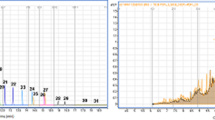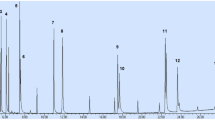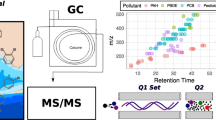Abstract
A gas chromatography/ion trap mass spectrometry method was developed for analysis of organochlorine pesticides (OCPs) in coral samples, which were extracted with accelerated solvent extraction (ASE) and cleaned up on a sulfuric acid-modified silica gel column. The optimal ASE conditions were found to be 100°C and 2000 psi, with a mixture of acetone and methylene chloride (1:1, v/v). The target analytes include hexachlorocyclohexanes (HCHs, specifically, α-, β-, γ-, and δ-HCH isomers), heptachlor, and hexachlorobenzene (HCB), o,p′-, p,p′-dichlorodiphenyltrichloroethane (o,p′-, p,p′-DDT), o,p′-, p,p′-dichlorodiphenyl-dichloroethylene (o,p′-, p,p′-DDE), and o,p′-, p,p′-dichlorodiphenyldichloroethane (o,p′-, p,p′-DDD). Standard sand samples were used as an alternative matrix spiked with OCP standards to determine the method precision and accuracy. Average recoveries of OCPs ranged from 82% to 102%, with relative standard deviations (RSDs) of 3%–6%, at a level of 10 ng/g and from 50% to 68%, with RSDs of 13%–19% at a level of 2 ng/g. The developed method was applied for analysis of OCPs in coral samples collected from Tern Island and Bikini Atoll in the Pacific Ocean. The concentrations of HCB were 7–26 pg/g dry weight in the samples from Bikini Atoll and 3–45 pg/g in those from Tern Island, and heptachlor concentrations were 208–2200 and 44–104 pg/g in the coral samples from Bikini Atoll and Tern Island, respectively. ∑HCH (sum of α-, β-, γ-, and δ-HCH) were 8–82 pg/g in Bikini Atoll coral and 86–629 pg/g in Tern island coral, and ∑DDT (sum of o,p′-, p,p′-DDD, o,p′-, p,p′-DDE, and o,p′- p,p′-DDT) were 80–212 pg/g in Bikini Atoll coral and 593–3165 pg/g in Tern Island coral. The results suggest that coral is a viable indicator species for pollution monitoring, which pollutants and their concentrations may be related to dated carbonate layers.



Similar content being viewed by others
References
Ahmad UK, Ujang Z, Woon CH, Indran S, Mian MN (2004) Development of extraction procedures for the analysis of polycyclic aromatic hydrocarbons and organochlorine pesticides in municipal sewage sludge. Water Sci Technol 50:137–144
Ahmed E (2003) Analysis of polychlorinated biphenyls in food products. Trends Anal Chem 22:170–185
Björklund E, Nilsson T, Bøwadt S (2000) Pressurised liquid extraction of persistent organic pollutants in environmental analysis. Trends Anal Chem 19:434–445
Concha-Grana E, Turnes-Carou MI, Muniategui-Lorenzo S, Lopez-Mahia P, Fernandez-Fernandez E, Prada-Rodriguez D (2004) Development of pressurized liquid extraction and cleanup procedures for determination of organochlorine pesticides in soils. J Chromatogr A 1047:147–155
Delgado JP (1996) Ghost fleet, the sunken ships of Bikini Atoll. University of Hawaii Press, Honolulu, p 204
Eljarrat E, Barceló D (2004) Sample handling and analysis of brominated flame retardants in soil and sludge samples. Trends Anal Chem 23:727–736
El Nemr A, El-Sikaily A, Khaled A, Said TO, Abd-Allah AMA (2004) Chlorinated pesticides and polychlorinated biphenyls in the coral reef skeleton of the Egyptian Red Sea Coast. Bull Environ Contam Toxicol 72:1195–1202
El-Sikaily A, Khaled A, EI Nemr A, Said TO, Abd-Alla AMA (2003) Polycyclic aromatic hydrocarbons and aliphatics in the coral reef skeleton of the Egyptian Red Sea Coast. Bull Environ Contam Toxicol 71:1252–1259
Fatoki OS, Awofolu RO (2003) Methods for selective determination of persistent organochlorine pesticide residues in water and sediments by capillary gas chromatography and electron-capture detection. J Chromatogr A 983:225–236
Fisher JA, Scarlett MJ, Stott AD (1997) Accelerated solvent extraction: an evaluation for screening of soils for selected U.S. EPA semivolatile organic priority pollutants. Environ Sci Technol 31:1120–1127
Frenich AG, Vidal JL, Frias MM, Olea-Serrano F, Olea N (2000). Quantitative determination of endocrine-disrupting polychlorinated biphenyls and organochlorinated pesticides in human serum using gas chromatography with electron-capture detection and tandem mass spectrometry. J Mass Spectrom 35:967–975
Gan J, Papiernik SK, Koskinen WC, Yates SR (1999) Evaluation of accelerated solvent extraction (ASE) for analysis of pesticide residues in soil. Environ Sci Technol 33:3249–3253
Glynn PW, Howard LS, Corcoran E, Freay AD (1984) The occurrence and toxicity of herbicides in reef building corals. Mar Pollut Bull 15:370–374
Hatcher BG, Johannes RE, Robertson AI (1989) Review of research relevant to the conservation of shallow tropical marine ecosystems. Ocean Mar Bio Annu Rev 27:337–414
Hawthorne SB, Grabanski CB, Martin E, Miller DJ (2000) Comparisons of Soxhlet extraction, pressurized liquid extraction, supercritical fluid extraction and subcritical water extraction for environmental solids: recovery, selectivity and effects on sample matrix. J Chromatogr A 892:421–433
Heemken OP, Theobald N, Wenclawiak BW (1997) Comparison of ASE and SFE with Soxhlet, sonication, and methanolic saponification extractions for the determination of organic micropollutants in marine particulate matter. Anal Chem 69:2171–2180
Hughes TP (1994) Catastrophes, phase shifts and large scale degradation of a Carribbean coral reef. Science 265:1547–1551
Khaled A, EI Nemr A, EI Sikaily A (2003) Contamination of coral reef by heavy metals along the Egyptian Red Sea coast. Bull Environ Contam Toxicol 71:577–584
Lopez-Avila V, Bauer K, Milanes J, Beckert WF (1993) Evaluation of soxtec extraction procedure for extracting organic compounds from soils and sediments. J AOAC Int 76:864–880
Loya Y, Rinkevich B (1980) Effects of oil pollution on coral reef communities. Mar Ecol Prog Ser 3:167–180
Martens D, Gferer M, Wenzl T, Zhang A, Gawlik BM, Schramm KW (2002) Comparison of different extraction techniques for the determination of polychlorinated organic compounds in sediment. Anal Bioanal Chem 372:562–568
Meehan W, Ostrander GK (1997) Coral bleaching: a potential biomarker of environmental stress. J Toxicol Environ Health 50:529–552
Miao XS, Swenson C, Woodward L, Li QX (2000a) Distribution of polychlorinated biphenyls in marine species from French Frigate Shoals, North Pacific Ocean. Sci Total Environ 257:17–28
Miao XS, Swenson C, Yanagihara K, Li QX (2000b) Polychlorinated biphenyls and metals in marine species from French Frigate Shoals, North Pacific Ocean. Arch Environ Contam Toxicol 38: 464–471
Raloff J (1999) Sea sickness, marine epidemiology comes of age. Sci News 155:72–74
Rogers CS (1989) Responses of coral reefs and reef organisms to sedimentation. Mar Ecol Prog Ser 62:185–202
Pastorok RA, Bilyard GR (1985) Effect of sewage pollution on coral-reef communities. Mar Ecol Prog Ser 21:175–189
Patel K, Fussell RJ, Hetmanski M, Goodall DM, Keely BJ (2005) Evaluation of gas chromatography–tandem quadrupole mass spectrometry for the determination of organochlorine pesticides in fats and oils. J Chromatogr A 1068:289–296
Peters EC (1984) A survey of cellar reactions to environmental stress and disease in Caribbean scheractinian corals. Helgoländer Meeresunter 37:113–137
Phillips DJH, Tanabe S (1989) Aquatic pollution in the Far East. Mar Pollut Bull 20:297–303
Popp P, Keil P, Moëeder M, Paschke A, Thuss U (1997) Application of accelerated solvent extraction followed by gas chromatography, high-performance liquid chromatography and gas chromatography–mass spectrometry for the determination of polycyclic aromatic hydrocarbons, chlorinated pesticides and polychlorinated dibenzo-p-dioxins and dibenzofurans in solid wastes. J Chromatogr A 774:203–211
Pyle SM, Marcus ABJ (1997) Rapid and sensitive determination of pesticides in environmental samples by accelerated solvent extraction and tandem mass spectrometry. J Mass Spectrom 32:897–898
Richter BE, Jones BA, Ezzell JL, Porter NL, Avdalovic N, Pohl C (1996) Accelerated solvent extraction: a technique for sample preparation. Anal Chem 68:1033–1039
Richter BE, Ezzell JL, Knowles DE, Hoefler F, Mattulat AKR, Scheutwinkel M, Waddell DS, Gobran T, Khurana V (1997) Extraction of polychlorinated dibenzo-p-dioxins and polychlorinated dibenzofurans from environmental samples using accelerated solvent extraction (ASE). Chemosphere 34:975–987
Saim N, Dean JR, Abdullah P, Zakaria Z (1998) An experimental design approach for the determination of polycyclic aromatic hydrocarbons from highly contaminated soil using accelerated solvent extraction. Anal Chem 70:420–424
Sannino A, Mambriani P, Bandini M, Bolzoni L (1996) Multiresidue method for determination of organochlorine insecticides and polychlorinated biphenyl congeners in fatty processed foods. J AOAC Int 79:1434–1446
Schantz MM, Nichols JJ, Wise SA (1997) Evaluation of pressurized fluid extraction for the extraction of environmental matrix reference materials. Anal Chem 69:4210–4219
Serrano R, Barreda M, Pitarch E, Hernández F (2003) Determination of low concentrations of organochlorine pesticides and PCBs in fish feed and fish tissues from aquaculture activities by gas chromatography with tandem mass spectrometry. J Sep Sci 26:75–86
Sterzenbach D, Wenclawiak BW, Weigelt V (1997) Determination of chlorinated hydrocarbons in marine sediments at the part-per-trillion level with supercritical fluid extraction. Anal Chem 69:831–836
Tanabe S, Senthikumar K, Kannan K, Subramanian AN (1998) Accumulation features of polychlorinated biphenyls and organochlorine pesticides in resident and migratory birds from South India. Environ Contam Toxicol 34:387–397
Thompson S, Budzinski H, Garriguse P, Narbonne F (1999) Comparison of PCB and DDT distribution between water-column and sediment-dwelling bivalves in Arcachon Bay, France. Mar Pollut Bull 38:655–662
Thompson S, Budzinski H, LeMenach K, Letellier M, Garriges P (2002) Multi-residue analysis of polycyclic aromatic hydrocarbons, polychlorobiphenyls, and organochlorine pesticides in marine sediments. Anal Bioanal Chem 372:196–204
U.S. EPA (1998) Pressurized fliud extraction (PFE). Method 3545A. U.S. EPA, Washington, DC
Vetter W, Weichbrodt M, Scholz E, Luckas B, Oelschlager H (1999) Levels of organochlorines (DDT, PCBs, Toxaphene, Chlordane, Dieldrin, and HCHs) in blubber of South African Fur Seals (Arctocephalus pusillus pusillus) from Cape Cross/ Namibia. Mar Pollut Bull 38:830–836
Wang D, Atkinson S, Hoover-Miller A, Li QX (2005) Analysis of organochlorines in harbor seal (Phoca vitulina) tissue samples from Alaska using gas chromatography/ion trap mass spectrometry by an isotopic dilution technique. Rapid Commun Mass Spectrom 19:1815–1821
Wenzel KD, Hubert A, Manz M, Weissflog L, Engewald W, Schrann G (1998) Accelerated solvent extraction of semivolatile organic compounds from biomonitoring samples of pine needles and mosses. Anal Chem 70:4827–4835
Acknowledgments
This work was funded, partly, by the U.S. Fish and Wildlife Service and Hawaii Heptachlor Research & Education Foundation (HHHERP 98–05). We would like to acknowledge U. Hans Beiling of S. Cohen & Associates for providing the coral samples collected from Bikini Atoll, Republic of the Marshall Islands.
Author information
Authors and Affiliations
Corresponding author
Rights and permissions
About this article
Cite this article
Wang, D., Miao, X. & Li, Q.X. Analysis of Organochlorine Pesticides in Coral (Porites evermanni) Samples Using Accelerated Solvent Extraction and Gas Chromatography/Ion Trap Mass Spectrometry. Arch Environ Contam Toxicol 54, 211–218 (2008). https://doi.org/10.1007/s00244-007-9016-2
Received:
Accepted:
Published:
Issue Date:
DOI: https://doi.org/10.1007/s00244-007-9016-2




